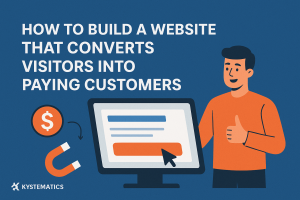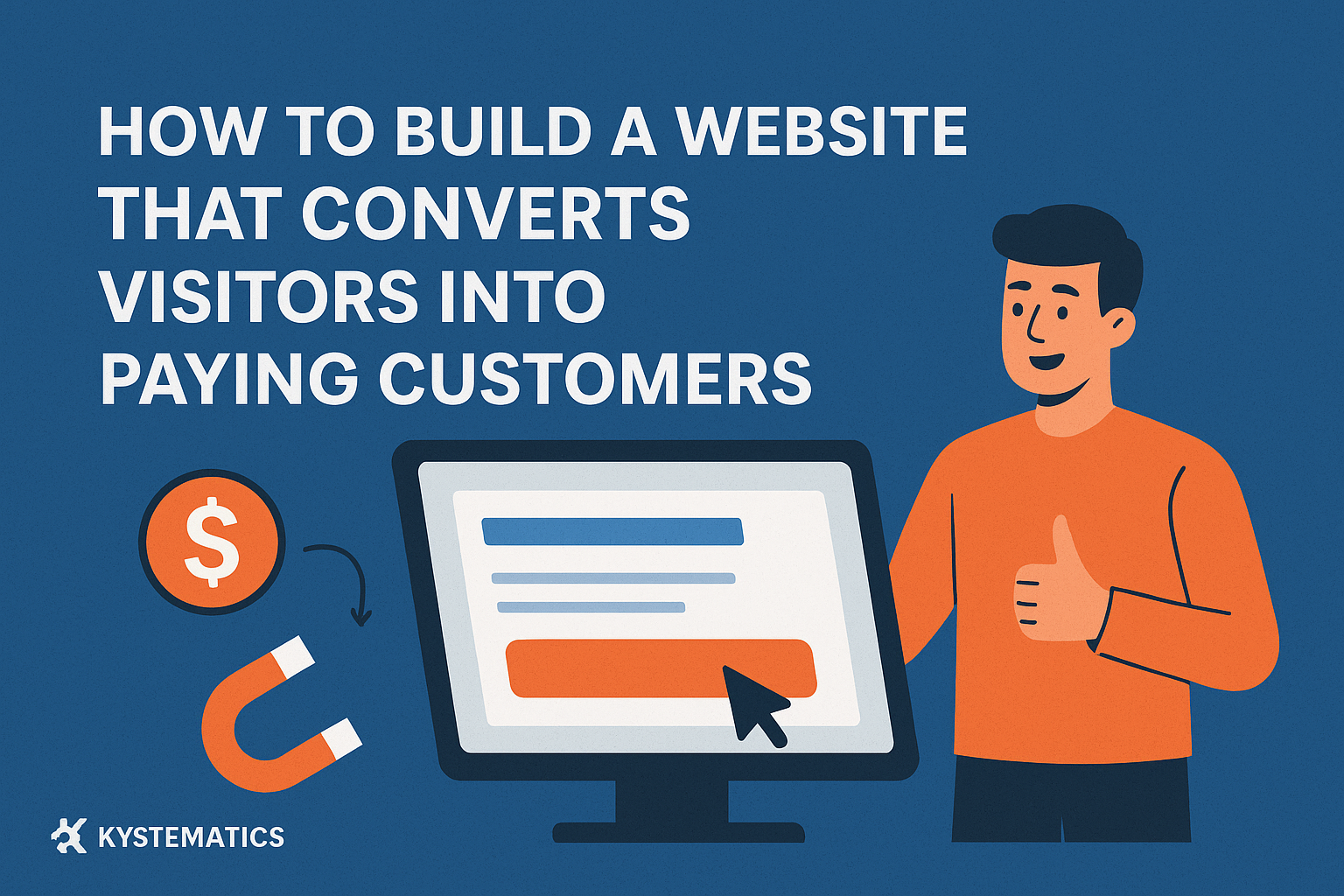How to Build a Website That Converts Visitors Into Paying Customers
In today’s digital marketplace, having a website isn’t enough — you need a website that sells. Every click, scroll, and interaction on your site should move your visitors one step closer to becoming paying customers. But how do you build a website that truly converts?
In 2026, conversion-focused web design has become both an art and a science. It’s about blending strategy, psychology, and technology into one seamless user experience. Whether you’re a small business owner or a large enterprise, this guide will walk you through the key principles of building a high-converting website — powered by insights and solutions from Ksystematics, a leader in digital marketing, automation, and web development.
Step 1: Understand Your Audience Deeply
Before you design a single page, you need to understand who you’re designing for. A website that converts is built on a foundation of customer insight — their needs, pain points, desires, and behaviors.
Use tools like surveys, heatmaps, and analytics to understand how visitors interact with your current site. Identify what’s stopping them from converting — is it unclear messaging, poor navigation, or slow loading speed?
With Ksystematics’ analytics and automation tools, businesses can dig deep into user behavior and get actionable data. You’ll know exactly which pages attract attention and which ones lose potential customers.
Understanding your audience helps you build a user journey that feels effortless and personal — the first step toward higher conversions.
Step 2: Craft a Clear and Compelling Value Proposition
Your value proposition is your website’s elevator pitch. Within seconds, visitors should understand what you offer and why they should care.
Ask yourself:
-
What problem am I solving?
-
Why am I different?
-
What’s the main benefit to the customer?
For example, instead of saying “We build websites”, say “We create performance-driven websites that turn clicks into customers.”
Ksystematics specializes in helping businesses define and communicate their unique value proposition through strategic content, visuals, and design elements — ensuring that every visitor instantly understands the brand’s value.
Step 3: Design With Conversions in Mind
The design of your website directly impacts how users behave. Clean, intuitive layouts with clear navigation reduce friction and build trust. Cluttered, confusing designs do the opposite.
Key conversion-focused design elements include:
-
Prominent CTAs (Call-to-Action): Use strong, action-oriented words like “Get Started”, “Book a Free Demo”, or “Claim Your Offer”.
-
White Space: Avoid overwhelming users with too much content or visuals.
-
Visual Hierarchy: Highlight the most important elements — your offers, testimonials, and CTAs.
-
Consistent Branding: Build credibility through consistent colors, fonts, and messaging.
With Ksystematics’ professional web development services, businesses can implement conversion-driven design principles that not only attract attention but also guide visitors naturally toward action.
Step 4: Optimize for Speed and Performance
A one-second delay in website loading time can reduce conversions by up to 20%. Users today expect instant gratification — if your site takes too long to load, they’ll leave before even seeing your offer.
Ksystematics ensures that websites are built using the latest technologies, optimized images, and efficient coding frameworks to deliver lightning-fast performance across all devices.
Moreover, mobile responsiveness is non-negotiable. Over 70% of web traffic now comes from smartphones, so a mobile-optimized website is crucial for keeping users engaged and converting on the go.

Step 5: Leverage the Power of Persuasive Copy
Your words can make or break conversions. Good design attracts visitors, but persuasive copy convinces them to buy.
Here’s how to write copy that converts:
-
Use emotional triggers: Focus on outcomes, not just features.
-
Keep it concise: Every word should serve a purpose.
-
Build trust: Add social proof, case studies, or testimonials.
-
Create urgency: Limited-time offers and scarcity can drive quicker action.
Ksystematics’ content and SEO experts craft engaging, high-impact copy tailored for conversions. Every headline, button, and paragraph is written to guide users naturally toward taking the next step.
Step 6: Integrate Automation for Smarter Lead Capture
Modern websites don’t just collect leads — they nurture them automatically. By integrating automation tools, you can follow up instantly when someone signs up, downloads a brochure, or requests a demo.
Ksystematics’ marketing automation solutions help businesses set up intelligent workflows that send personalized emails, follow-ups, and reminders based on user behavior. This ensures no lead slips through the cracks and that every potential customer feels valued.
Automation also allows real-time lead scoring, helping your sales team prioritize high-value prospects for faster conversions.
Step 7: Use Data to Test, Measure, and Improve
The most successful websites are never “finished.” Continuous improvement is the secret to staying ahead.
Monitor your conversion metrics — bounce rate, session duration, click-through rate, and form completions. Conduct A/B tests to see which designs, headlines, or CTAs perform best.
Ksystematics empowers businesses with deep analytics dashboards that track performance across all digital touchpoints. These insights help you make data-driven decisions that steadily improve conversion rates over time.
Step 8: Build Trust Through Social Proof and Transparency
Trust is a major factor in conversion. People buy from brands they feel confident about.
Add:
-
Customer testimonials and success stories
-
Client logos or partnership badges
-
Secure payment badges and privacy assurances
Ksystematics helps brands showcase authenticity and credibility through strategic content placement, review integration, and reputation management tools — turning trust into tangible sales growth.
Step 9: Create Seamless User Journeys
From the homepage to checkout, your website should guide visitors smoothly toward their goals. Each click should feel intuitive.
Smart UX design, clear navigation, and strategically placed CTAs ensure that visitors never get lost or distracted.
Ksystematics’ design experts specialize in creating seamless, user-focused journeys that reduce friction and increase the likelihood of conversion.
Step 10: Personalize the Experience
One-size-fits-all websites don’t convert anymore. Personalization is now the key to engagement.
With AI-driven tools from Ksystematics, businesses can display personalized product recommendations, dynamic landing pages, and targeted pop-ups based on each visitor’s interests and behavior.
This makes every visitor feel like the website was built specifically for them — boosting both engagement and sales.
Why Choose Ksystematics for High-Converting Websites
Building a beautiful website is easy. Building one that converts is where expertise matters — and that’s where Ksystematics stands out.
From strategic planning and design to SEO optimization, automation, and analytics, Ksystematics provides end-to-end solutions tailored to your business goals. Their team of experts combines creative design with data-driven technology to deliver measurable results.
Partnering with Ksystematics means your website won’t just look good — it will work hard for you, turning visitors into loyal, paying customers.
Conclusion
In 2026, the difference between a website that exists and one that sells lies in its ability to engage, persuade, and convert. By focusing on your audience, optimizing design, leveraging automation, and continuously testing your strategies, you can create a digital experience that drives revenue growth.
With Ksystematics by your side, you’re not just building a website — you’re building a powerful conversion engine that grows your business 24/7.
Follow Ksystematics at Facebook/Instagram/Linkedin
